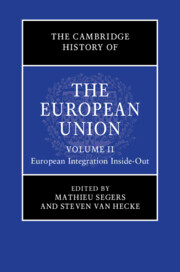Book contents
- The Cambridge History of the European Union
- The Cambridge History of the European Union
- The Cambridge History of the European Union
- Copyright page
- Contents
- Figures
- Tables
- Contributors to Volume II
- Acknowledgements
- Abbreviations
- Reflections on the History and Historiography of European Integration
- Part I Milestones: Treaties and Treaty Changes
- 1 Early Forms of European Unity
- 2 From Messina and Rome to the Single European Act
- 3 The Making of the European Union
- 4 From Maastricht and Copenhagen to Amsterdam and Nice
- 5 The Constitution Project, Lisbon and Beyond
- 6 Moving beyond British Exceptionalism
- Part II Instruments of Integration
- Part III Narratives and Outcomes
- Index
- References
4 - From Maastricht and Copenhagen to Amsterdam and Nice
from Part I - Milestones: Treaties and Treaty Changes
Published online by Cambridge University Press: 12 October 2023
- The Cambridge History of the European Union
- The Cambridge History of the European Union
- The Cambridge History of the European Union
- Copyright page
- Contents
- Figures
- Tables
- Contributors to Volume II
- Acknowledgements
- Abbreviations
- Reflections on the History and Historiography of European Integration
- Part I Milestones: Treaties and Treaty Changes
- 1 Early Forms of European Unity
- 2 From Messina and Rome to the Single European Act
- 3 The Making of the European Union
- 4 From Maastricht and Copenhagen to Amsterdam and Nice
- 5 The Constitution Project, Lisbon and Beyond
- 6 Moving beyond British Exceptionalism
- Part II Instruments of Integration
- Part III Narratives and Outcomes
- Index
- References
Summary
The cities in the title of this contribution were the locations of summits at which European Community (EC)/European Union (EU) leaders made historic decisions that shaped the future of the European project. At three of those summits – Maastricht in December 1991, Amsterdam in June 1997 and Nice in December 2000 – leaders agreed on changes to the founding treaties on which the EC and the EU are based. Of the three treaty changes, which subsequently bore the names of the cities themselves, Maastricht was by far the most consequential, not only because it ushered in the EU but also because of its provisions for Economic and Monetary Union (EMU), the Common Foreign and Security Policy (CFSP) and cooperation on Justice and Home Affairs.
- Type
- Chapter
- Information
- The Cambridge History of the European Union , pp. 118 - 142Publisher: Cambridge University PressPrint publication year: 2023

